The SATA hard drive installs into a plastic support
caddy and is connected with a standard hot swappable SATA data and
power jack at the rear. A few screws (included) ensure the hard drive stays
put. The entire assembly is slid back into the aluminum chassis and then four small screws are used to
hold the metal back plate in place. That's all you need to do, and with
the aid of a screw driver this takes no more than about a
minute.
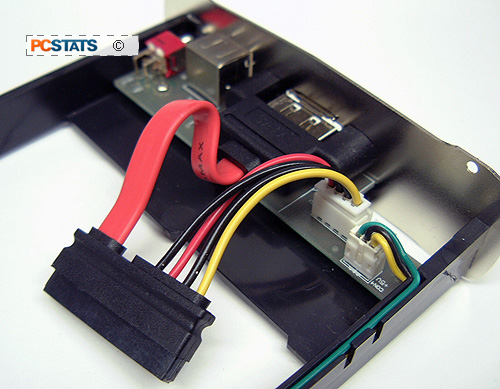
This is the internal plastic frame the hard drive is attached
to. All it really does is keep the drive from banging around, and ensure data
and power cables stay attached.
.
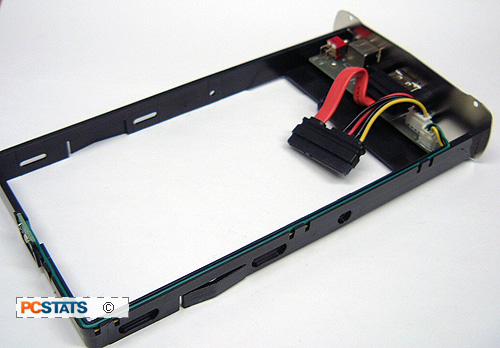
To unplug the bright blue LED, just remove the jumper wires at the
rear, far right, for the green and black wires. The hard drive must support
Serial ATA data & power connectors to work with this unit.
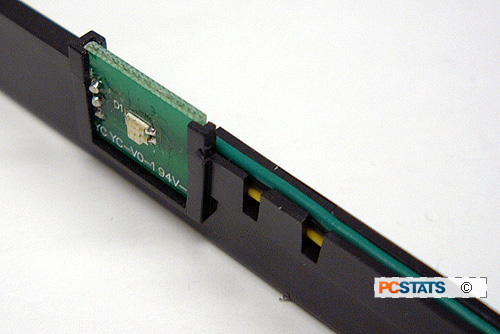
So long as you are running Windows XP
or Vista, and the removable hard drive caddy does not contain your operating
system, the PC will react pretty sensibly to the immediate removal or insertion of a
hard drive via the power button, or insertion or removal of the eSATA
cable.
It's best practice
to go to "removable devices" in the control panel and "stop" the hard
drive before pulling out the data cable or turning off the power, or data loss
may occur. This step ensures data integrity while the latter is a little
like playing russian roulette with your info. SATA is inherently hot swappable so it won't
affect the drive, although some low end motherboards may not be SATA hot swappable
compliant.
The general
build quality of the DataTec DS350 is nice, the aluminum
parts of the chassis have been sand blasted and anodized, so it will hold
up to little bumps and scrapes well enough. If the drive is powered on
and spinning, it's a good idea to leave the external enclosure alone and
don't move it around.
eSATA Device Support
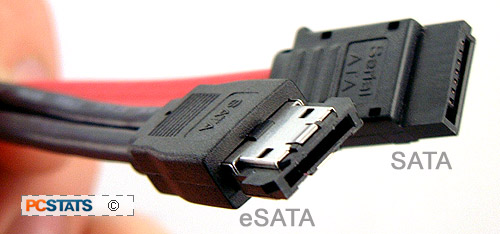 eSATA (aka external Serial ATA) support is easily
the most exciting feature to pop on motherboards of recent. When it comes to
external mass storage, bandwidth has always been, and will always be an issue.
USB 2.0 (480 Mbps) and IEEE 1394a/b (400/800 Mbps) offer better alternatives
than past connections like Serial and Parallel ports but they are still slow
compared to dedicated hard drive channels.
eSATA (aka external Serial ATA) support is easily
the most exciting feature to pop on motherboards of recent. When it comes to
external mass storage, bandwidth has always been, and will always be an issue.
USB 2.0 (480 Mbps) and IEEE 1394a/b (400/800 Mbps) offer better alternatives
than past connections like Serial and Parallel ports but they are still slow
compared to dedicated hard drive channels.
With the emergence
of Serial ATA, external storage took a huge step forward. Serial ATA is an
affordable solution (as opposed to SCSI) that offers speeds at well past
USB or IEEE 1394 levels.
Serial ATA generation I has up to 1.5Gbps worth of
bandwidth and Serial ATA generation II doubles that bandwidth to 3Gbps. Serial
ATA makes even IEEE 1394b's 800Mbps bandwidth look paltry by comparison.
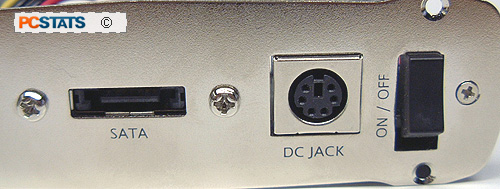 Standard
internal Serial ATA cables are sufficient for internal connections, but SATA-IO governing body decided
a while back that the external version should be somewhat different, thus creating the eSATA
standard.
Standard
internal Serial ATA cables are sufficient for internal connections, but SATA-IO governing body decided
a while back that the external version should be somewhat different, thus creating the eSATA
standard.
The eSATA cable that accompanies
the DataTec DS350 is the
eSATA I ('eye' not 'one') type connector (of the two pictured, it is the left
one). There are also eSATA L connectors floating around, so we'd advise you to
double check what type of connector end is on any kind of cables you might pick
up.
The great thing about eSATA
enclosures is that hard drives connected over this standard are just as fast as
internal SATA devices. The connectors are hot swappable, so it makes adding and
removing an external hard drive about as complex as clipping in a USB memory
key.
